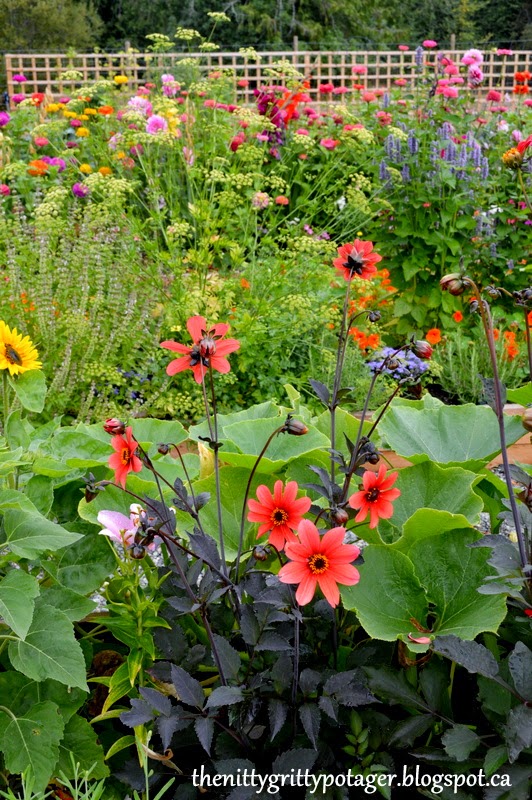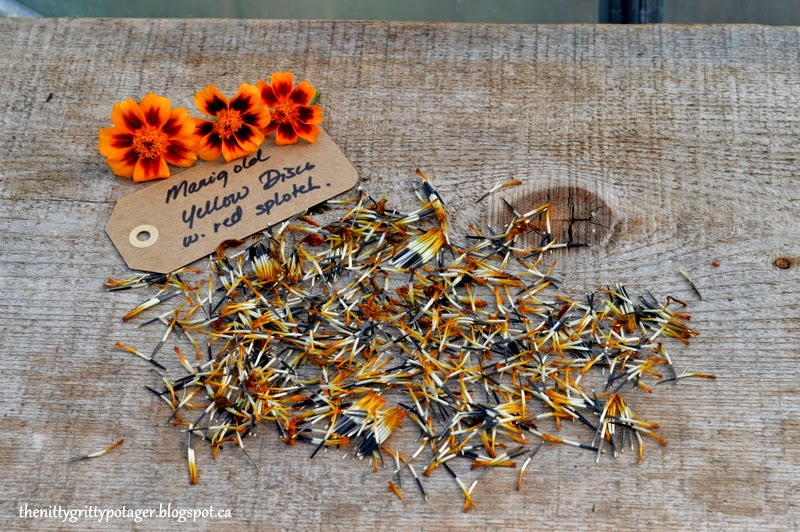How To Save Those Seeds
My garden abounds with critters of all kinds, bees a buzzing, snakes a slithering, frogs a hopping, spiders a webbing and lizards a ... creeping (?) ...All kinds of creatures big and small, that make for a really healthy and happy kitchen garden-scape. Annuals contribute to the health and happiness of my gardens by bringing in all these garden helpers, repelling bad bugs, and also adding colour and a cutting garden, thus bringing joy to my heart and hearth, as well.
Here are four really easy annuals to collect seed from and start yourself next year.... Nasturtiums, Calendula, Marigolds, and Sweet Williams.
Nasturtiums add a great pop of colour to the garden, are a real treat cascading over the sides of the raised beds or vining and clambering over and through the beds.
They are a favourite flower of the hummingbirds, too, who just happen to eat lots of bugs, besides being wonderful to watch.
They also work as a lure crop, plant them near your cabbages to keep the aphids on the nasturtiums and not on your heads!
Best of all, the flowers of the nasturtium are delicious to eat ... add them to salads for both the colourful pop and for their peppery taste.
To save Nasturtium seeds...
Look amongst the foliage for the twisty stems of the spent blooms for these round, lovely seeds.
They may be brown or green, either works just fine and they may be in clusters of two or three, like you see here in the picture, or they may be singles. The green ones will be clinging to the stems while the brown ones will have fallen onto the ground. Both will dry and store and grow equally well next year.
Pick the beautiful, ribbed, round seeds....
Always choose the biggest seeds for the best plants, and pick only from your healthiest, happiest, most thriving-est plants.
Lay them out to dry in a dry, sunny, warm and well-ventilated spot to dry.
Package them up after they have dried completely, in either an envelope or glass jar. Label and save till spring. If they are still damp, they will rot in the packaging. Give them lots of time to dry thoroughly.
Pot Marigold aka Calendula ...
These super bright and happy flowers are also edible and are great companion plants near tomatoes and cabbage plants.
Calendula's are great dried and made into salves, soaps, ointments, teas, and balms of all kinds. They have antiseptic, anti-inflammatory, antibacterial and antifungal properties that prevent infections.
Pick the dry seed heads off of the calendula plant. If they are not yet dry, harvest the entire branch and let the flowers dry on the branch before harvesting.
Rub your finger along the dry flower head to loosen the seeds from the flower cap and leave out to dry thoroughly. You can also pop the branches of blooms into a paper bag to dry and the seeds will simply fall into the bag when dry.
The seeds are 'C' shaped curly cuties, that kind of look like caterpillars if picked when green.
 |
| Red Disco Marigolds |
The best companion plant of them all... repels aphids, hornworms and so much more... no kitchen garden is complete without marigolds.
My favourite is the Disco variety, that you see in the picture above.. love these single petaled red blooms most of all.
Snap the dried blooms off of the plant....
Remove the husk/cap from the spent blooms to reveal these lovely seeds ...
Lay them out, single layer, to dry. Make sure the drying area is warm, bright, dry and well ventilated to ensure that they dry properly.
Sweet William aka Dianthus barbatus
This sweet smelling addition is not actually an annual, but is a biennial that is stunning addition to the kitchen garden or perennial bed. A true heirloom flower that has been around since the 1500's!
Attracts bees, birds and butterflies to the garden, ensuring great pollination for all your crops!
Smells terrific and so is a great addition to the cutting garden, as well.
Pick the spent blooms and pop into a paper bag, the seeds will fall right into the bag as they dry. There are many small black seeds in each papery husk of the spent flowers.
Alternately, you can leave the spent blooms in the garden and they will scatter their seeds everywhere, for a blanket of this heavenly smelling, gorgeous biennial.


















Comments
Post a Comment